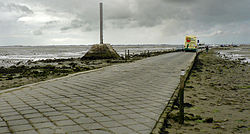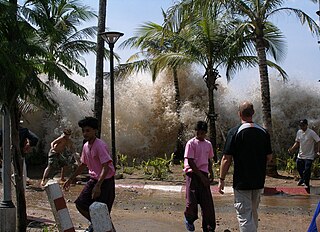
A tsunami is a series of waves in a water body caused by the displacement of a large volume of water, generally in an ocean or a large lake. Earthquakes, volcanic eruptions and other underwater explosions above or below water all have the potential to generate a tsunami. Unlike normal ocean waves, which are generated by wind, or tides, which are in turn generated by the gravitational pull of the Moon and the Sun, a tsunami is generated by the displacement of water from a large event.

A triathlon is an endurance multisport race consisting of swimming, cycling, and running over various distances. Triathletes compete for fastest overall completion time, racing each segment sequentially with the time transitioning between the disciplines included. The word is of Greek origin, from τρεῖς, 'three', and ἆθλος, 'competition'.

A megatsunami is a very large wave created by a large, sudden displacement of material into a body of water.

The Col du Galibier is a mountain pass in the southern region of the French Dauphiné Alps near Grenoble. It is the eighth highest paved road in the Alps, and recurrently the highest point of the Tour de France.

A tidal bore, often simply given as bore in context, is a tidal phenomenon in which the leading edge of the incoming tide forms a wave of water that travels up a river or narrow bay, reversing the direction of the river or bay's current. It is a strong tide that pushes up the river, against the current.

Tidal race or tidal rapid is a natural occurrence whereby a fast-moving tide passes through a constriction, resulting in the formation of waves, eddies and hazardous currents. The constriction can be a passage where the sides narrow, for example the Gulf of Corryvreckan and the Saltstraumen maelstrom, or an underwater obstruction, such as is found at the Portland Race in the United Kingdom.

Pelorus Sound is the largest of the sounds which make up the Marlborough Sounds at the north of the South Island, New Zealand.
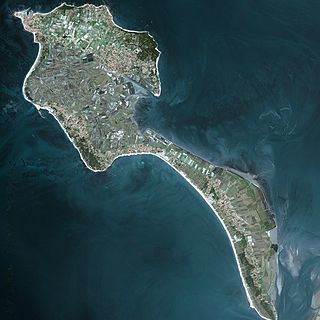
Noirmoutier is a tidal island off the Atlantic coast of France in the Vendée department (85).

The 1999 Tour de France was a multiple stage bicycle race held from 3 to 25 July, and the 86th edition of the Tour de France. It has no overall winner—although American cyclist Lance Armstrong originally won the event, the United States Anti-Doping Agency announced in August 2012 that they had disqualified Armstrong from all his results since 1998, including his seven consecutive Tour de France wins from 1999 to 2005 ; the Union Cycliste Internationale confirmed the result.

The Passage du Gois or Gôa is a causeway between Beauvoir-sur-Mer and the island of Noirmoutier, in Vendée on the Atlantic coast of France. The causeway is 4.125 kilometres (2.6 mi) long and is flooded twice a day by the high tide. A road runs along the causeway.
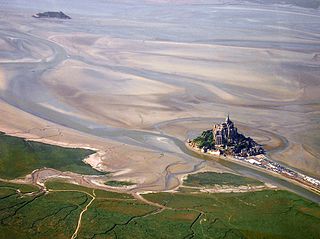
The Mont-Saint-Michel Bay is located between Brittany and the Normandy peninsula of Cotentin. The bay was listed as a UNESCO world heritage site in 1979 for its aesthetic quality and its importance to the Christian tradition. Due to the significant tidal movements in this region a large part of the bay is uncovered at low tide. There are two granitic islands in the bay: Tombelaine and the Mont-Saint-Michel. Many birds and harbor seals live in this area.
The Alderney Race is a strait that runs between Alderney and Cap de la Hague, a cape at the northwestern tip of the Cotentin Peninsula in Normandy. A strong current runs through the race north of the Passage de la Déroute, a treacherous passage separating the Cotentin from the Channel Islands. The current is intermittent, varying with the tide, and can run up to about 12 knots during equinoctial tides. The French call it Raz Blanchard. In Norman French it is called L'Raz.
Dominique Chauvelier is a French former long-distance runner who competed in marathons. His greatest international achievement was a bronze medal in the marathon at the 1990 European Athletics Championships.

The Bay of Bourgneuf is a bay situated on the French Atlantic coast, at the border of the Loire-Atlantique and Vendée departments. In the Middle Ages the bay was known as the baie de Bretagne or baye de Bretagne.

The Noirmoutier Bridge is a bridge located on the west coast of France in the department of Vendée, built in the early 1970s to connect the island of Noirmoutier to the mainland. Before it opened, a maritime shuttle service ran between the La Fosse pier on the island and Fromentine pier on the mainland.
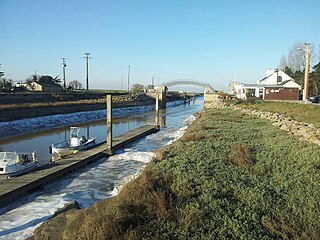
The Falleron is a French coastal river forming the boundary between the departments of Vendée and Loire-Atlantique and flowing into the Bay of Biscay and Atlantic Ocean via the Bay of Bourgneuf.
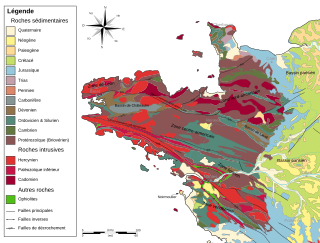
The 1799 Vendée earthquake or Bouin earthquake was a magnitude 6.4 earthquake that struck the Vendée area of western France on 25 January 1799 with aftershocks on the following days. Its epicenter was located at a depth of 24 km in the Bay of Bourgneuf at the level of the island of Bouin. Shocks of intensity VII–VIII were felt throughout the west of France.

The Haute Perche Canal, despite its title, is a natural river, the Rivière de Haute-Perche, that has been slightly canalised to improve navigation between its mouth in the Bay of Bourgneuf at the port town of Pornic and the upstream settlements of Le Clion-sur-Mer, Chauvé and Arthon-en-Retz. It is located in the Pays de Retz in the Loire-Atlantique department and the Pays de la Loire region. It has also been known as the Canal de Pornic since the 16th century and was sometimes called the Étier de Haute Perche. Historically, it was called the Rouet, after the wheels of the water mills in the port.
Dario Verani is an Italian competitive open water swimmer. At the 2022 World Aquatics Championships, he won the world title and gold medal in the 25 kilometre open water swim. He won the silver medal in the 25 kilometre open water swim at the 2022 European Aquatics Championships and the bronze medal in the 5 kilometre open water swim at the 2020 European Aquatics Championships. He was champion in the 5 kilometre open water swim at the inaugural Mediterranean Beach Games in 2015.

The Battle of Noirmoutier was a confrontation in the War in the Vendée which took place on 3 January 1794 between the Republicans and the Vendeans for control of the island of Noirmoutier.
